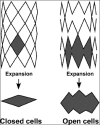The role of stents in the treatment of congenital heart disease: Current status and future perspectives
- PMID: 20300265
- PMCID: PMC2840765
- DOI: 10.4103/0974-2069.52802
The role of stents in the treatment of congenital heart disease: Current status and future perspectives
Abstract
Intravascular or intracardiac stenoses occur in many forms of congenital heart disease (CHD). Therefore, the implantation of stents has become an accepted interventional procedure for stenotic lesions in pediatric cardiology. Furthermore, stents are know to be used to exclude vessel aneurysm or to ensure patency of existing or newly created intracardiac communications. With the further refinement of the first generation of devices, a variety of "modern" stents with different design characteristics have evolved. Despite the tremendous technical improvement over the last 20 years, the "ideal stent" has not yet been developed. Therefore, the pediatric interventionalist has to decide which stent is suitable for each lesion. On this basis, currently available stents are discussed in regard to their advantages and disadvantages for common application in CHD. New concepts and designs developed to overcome some of the existing problems, like the failure of adaptation to somatic growth, are presented. Thus, in the future, biodegradable or growth stents might replace the currently used generation of stents. This might truly lead to widening indications for the use of stents in the treatment of CHD.
Keywords: Stenting; aortic coarctation; newer stent designs; patent ductus arteriosus; pulmonary artery stenosis.
Conflict of interest statement
Figures

Similar articles
-
Intravascular and intracardiac stents used in congenital heart disease.Curr Opin Cardiol. 2001 Mar;16(2):84-91. doi: 10.1097/00001573-200103000-00002. Curr Opin Cardiol. 2001. PMID: 11224638 Review.
-
Stenting in paediatric and adult congenital heart diseases: A French multicentre study in the current era.Arch Cardiovasc Dis. 2015 Dec;108(12):650-60. doi: 10.1016/j.acvd.2015.07.002. Epub 2015 Oct 1. Arch Cardiovasc Dis. 2015. PMID: 26429775
-
Transcatheter Intervention for Congenital Defects Involving the Great Vessels: JACC Review Topic of the Week.J Am Coll Cardiol. 2021 Jan 5;77(1):80-96. doi: 10.1016/j.jacc.2020.11.019. J Am Coll Cardiol. 2021. PMID: 33413945 Review.
-
[Therapeutic effect of Cheatham-Platinum stent implantation for vessel stenosis associated with congenital heart disease in children and adolescents].Zhonghua Er Ke Za Zhi. 2009 Apr;47(4):255-9. Zhonghua Er Ke Za Zhi. 2009. PMID: 19555561 Chinese.
-
Role of stents in congenital heart disease.Expert Rev Cardiovasc Ther. 2005 Mar;3(2):261-9. doi: 10.1586/14779072.3.2.261. Expert Rev Cardiovasc Ther. 2005. PMID: 15853600 Review.
Cited by
-
Right ventricular outflow tract stenting promotes pulmonary artery development in tetralogy of fallot.Front Surg. 2023 Feb 13;10:1056772. doi: 10.3389/fsurg.2023.1056772. eCollection 2023. Front Surg. 2023. PMID: 36860944 Free PMC article.
-
The role of the new Valeo stent in treating pulmonary artery stenoses in children with complex cardiac malformations: A report of two cases.Am J Case Rep. 2014 Jun 26;15:275-9. doi: 10.12659/AJCR.890455. eCollection 2014. Am J Case Rep. 2014. PMID: 24987491 Free PMC article.
-
Valeo Stent Use for Ductal-Dependent Systemic Circulations.Pediatr Cardiol. 2025 Jun 26. doi: 10.1007/s00246-025-03931-4. Online ahead of print. Pediatr Cardiol. 2025. PMID: 40569434
-
Virtual Planning and Patient-Specific Graft Design for Aortic Repairs.Cardiovasc Eng Technol. 2024 Apr;15(2):123-136. doi: 10.1007/s13239-023-00701-2. Epub 2023 Nov 20. Cardiovasc Eng Technol. 2024. PMID: 37985613
-
Stent Angioplasty for Critical Native Aortic Coarctation in Three Infants: Up to 15-Year Follow-Up Without Surgical Intervention and Review of the Literature.Pediatr Cardiol. 2018 Dec;39(8):1501-1513. doi: 10.1007/s00246-018-1922-8. Epub 2018 Jun 12. Pediatr Cardiol. 2018. PMID: 29948027
References
-
- Rashkind WJ, Miller WW. Creation of an atrial septal defect without thoracotomy. A palliative approach to complete transposition of the great arteries. JAMA. 1966;196:991–2. - PubMed
-
- Dotter CT, Judkins MP. Transluminal Treatment of Arteriosclerotic Obstruction. Description of a New Technic and a Preliminary Report of Its Application. Circulation. 1964;30:654–70. - PubMed
-
- Dotter CT. Transluminally-placed coilspring endarterial tube grafts. Long-term patency in canine popliteal artery. Invest Radiol. 1969;4:329–32. - PubMed
-
- Mullins CE, O'Laughlin MP, Vick GW, 3rd, Mayer DC, Myers TJ, Kearney DL, et al. Implantation of balloon-expandable intravascular grafts by catheterization in pulmonary arteries and systemic veins. Circulation. 1988;77:188–99. - PubMed
-
- O'Laughlin MP, Perry SB, Lock JE, Mullins CE. Use of endovascular stents in congenital heart disease. Circulation. 1991. pp. 1923–39. - PubMed
LinkOut - more resources
Full Text Sources
Other Literature Sources

